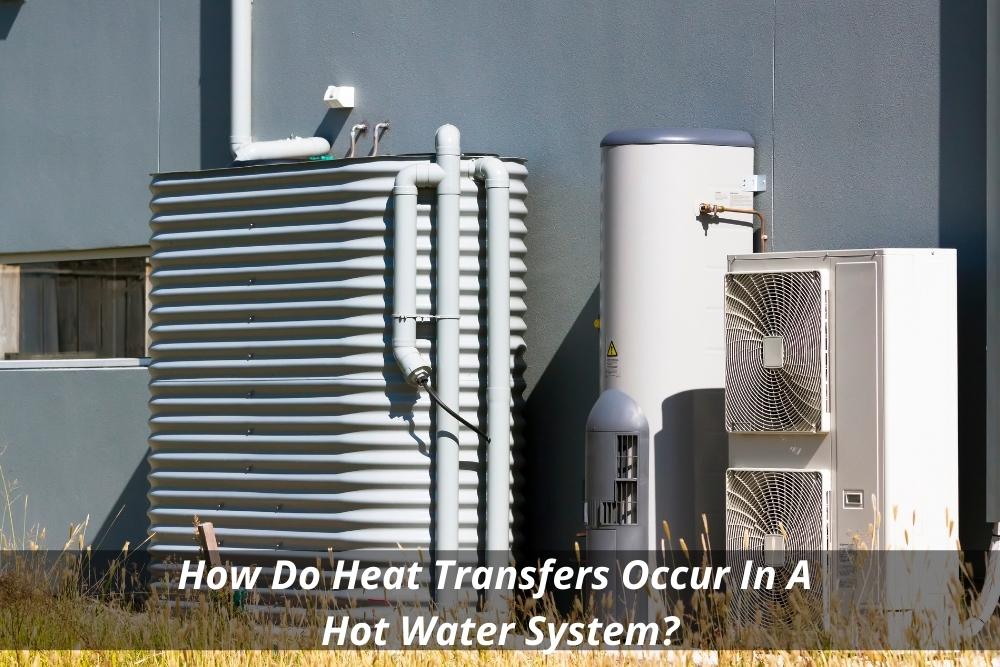Hot water systems are very common in homes and businesses. They provide hot water for showers, baths, washing machines, dishwashers, etc. The main components of hot water systems include the boiler, pump, piping, valves, thermostat, and tank.
Heat transfer occurs through conduction, convection, radiation, or a combination of these three processes. In a hot water system, the boiler heats the water and sends it into the pipes via a pump. This heated water then travels through the pipes and enters the tank where it cools down before being pumped back out of the tank to the various fixtures.
Heat transfer can be described as either an endothermic process (where heat is absorbed) or exothermic (where heat is given off). An example of an endothermic process would be mixing cement and water; when added together they become one solid substance that requires more heat to break apart than it did at first. On the other hand, an exothermic process is an example of how some materials give off heat such as adding wood to a fire and burning the wood thus releasing heat that was previously trapped within the material. This means that heat will always enter our atmosphere due to this property of all matter absorbing heat energy on its surface.
The most effective way to store thermal energy is by using a large insulated storage tank. This prevents heat loss while still allowing the tank to maintain its internal temperature. When the heater turns on, the warm air inside the tank absorbs the excess heat and maintains its internal temperature until the tank reaches the desired temperature setting.
The cost of running hot water systems depends upon many factors including the type of heating unit used, the size of the house, and the number of people living there. Most home hot water systems use natural gas combined with electric resistance heat. These types of boilers have the lowest level of efficiency because they have the least amount of insulation surrounding them. A typical domestic boiler has less than 50% overall efficiency. It takes about 70-75% of the electrical power provided to the furnace/boiler to produce the same amount of heat output. Thus, only 25-30% of the available energy goes toward keeping the water hot.
What happens when cold water enters a hot water tank?
Most homes have an emergency backup supply of cold water so that if the primary source fails, you don’t lose your shower or tub function. However, sometimes the cold water gets “stale” and no longer flows properly. To solve this problem, you need to flush the line between the cold water pipe and the hot water tank, which should clear itself up in under ten minutes. If it doesn’t, call the plumber!
You may also want to add some chlorine bleach to help prevent nasty bacteria growth in the lines.
If you’re not sure what’s wrong, try flushing the line yourself. Remove the faucet handle, turn the spout clockwise, hold the spout firmly against the drain hole, and start turning counterclockwise. The water pressure will force the water through the line. If this works, congratulations: You’re doing it right! If the whole thing comes out like a waterfall, though, you’ll need to call a pro.
Why does my hot water get colder after I’ve been running for a while?
It sounds crazy, but the reason why your hot water might get cooler over time is actually pretty simple. As the hot water warms up, it expands slightly. Since the volume of the tank isn’t changing, this forces the hot water to rise higher. Eventually, the hot water runs out of room in the tank, and it spills over into the cold water compartment. That’s why, when you take a bath, you don’t feel hot anymore.
What is thermal expansion and how does it affect your home?
Thermal expansion describes the tendency of solid objects (like pipes) to change shape as they absorb or release energy. In other words, as hot water heats up, it expands more than cold water. That’s why when you first turn on the tap, the water squirts out at a high velocity, then slows down as it cools and contracts.
When cold water moves from a low-pressure area (the bottom of the tank) to a high-pressure area (the top), it becomes full of tiny bubbles. When these bubbles reach the surface, they quickly burst, creating a loud popping sound. Over time, however, the bubbles grow larger and larger, absorbing energy as they move upward. Eventually, the noise of the bubbling stops completely, leaving behind a quiet pool of water.
What is conduction and how does it work in a hot water heater?
Conduction occurs when two surfaces come into contact and share their heat. This can be seen by holding your hand close to a radiator, where it feels warm. Heat travels from one side of your hand to another via direct contact.
In order to keep the hot water flowing freely, most manufacturers place a metal plate called a “conductor” around the outside of the hot water tank. This condenser allows the steam inside the tank to escape without getting trapped by the insulating material surrounding the tank. Steam is created whenever water boils; it’s just a bit denser than regular air. Conduction prevents the steam from escaping entirely, allowing it to stay within the tank until it reaches the end of the condenser.
What is convection and how does it work with a hot water heater?
Convection happens when hot fluids surround any object that gets too far away from the heat source (like a burner). The liquid flows toward the hotter part of the fluid and rises up, carrying heat along with it. This phenomenon is visible in a hot tub, where the water always stays about 1 inch above the bottom.
Convection doesn’t necessarily mean that the liquid is rising. It could also move downward if there’s an imbalance between hot and cold liquids. For example, say you have some boiling water and ice sitting next to each other on a table. The boiling water would probably begin to sink because it has less mass than the ice. That’s why even though the hot water sits lower than the cold water, it will eventually climb back to its previous level.
Convection only works efficiently if the hot water and cold water are separated by a thin layer of water. If there’s no gap between them, you may see what looks like waves on top of the water.
What causes cold spots in a hot water heater?
If the hot water lines aren’t insulated properly, they’ll carry the heat directly to the cold water line, causing a sudden drop in temperature. The cold spot creates a pressure difference, which draws additional hot water up from the bottom of the tank. This extra supply reduces heat loss and maintains a steady supply of hot water.
To prevent this problem, most hot water tanks have insulation that covers the entire bottom wall.
What causes a hot water heater to overheat?
Heat loss usually isn’t the problem. Instead, overheating results when too much hot water leaves the storage tank. Since the hot water must pass through the pipe before leaving the tank, all the water becomes quickly heated. At high temperatures, the pipes expand and leak more rapidly. This causes the hot water to pour out faster and lose heat.
Overheated water can damage the tank and cause serious injury. To avoid this, look for signs of leaks in the flue pipe at the outlet of the tank. You should also check the flue pipe area to make sure the connection is tight as well as the valve itself. It might help to turn off the power to the unit while checking these areas.
Other possible problems include:
– Dirty vents – Make sure your vent cap is tightly attached to the base of the unit. If it’s missing, leave it open when using the appliance. Replace this filter regularly so dirt doesn’t collect on it.
– Dirty flues – Clean your chimney frequently to remove debris and burnt gasses. A clogged vent can burn out the electrical connections and lead to overheating.
– Improperly installed hoses – Check the hose connections for cracks or leaks. Hose replacement is relatively easy. Just cut the old tube lengthwise, then slide a new piece of tubing into position. Use pliers to tighten the ends of the connector together.
– Too many appliances connected – Never overload a hot water tank with several appliances running simultaneously. Overloading can potentially damage the unit. If one device shuts down, the others won’t work. Conversely, running multiple devices without enough capacity will waste money on unnecessary energy usage.
– Excessive use of laundry detergents – Most detergent labels recommend adding 1/8 teaspoon (1 ml) per quart (litre) of water. Detergent can increase the number of minerals present in the water and affect the performance of the unit.
– Inefficient heat exchanger – Some older units used aluminium fins instead of copper coils to save money. Aluminium conducts heat poorly; however, newer models use copper coils to maximize efficiency.


